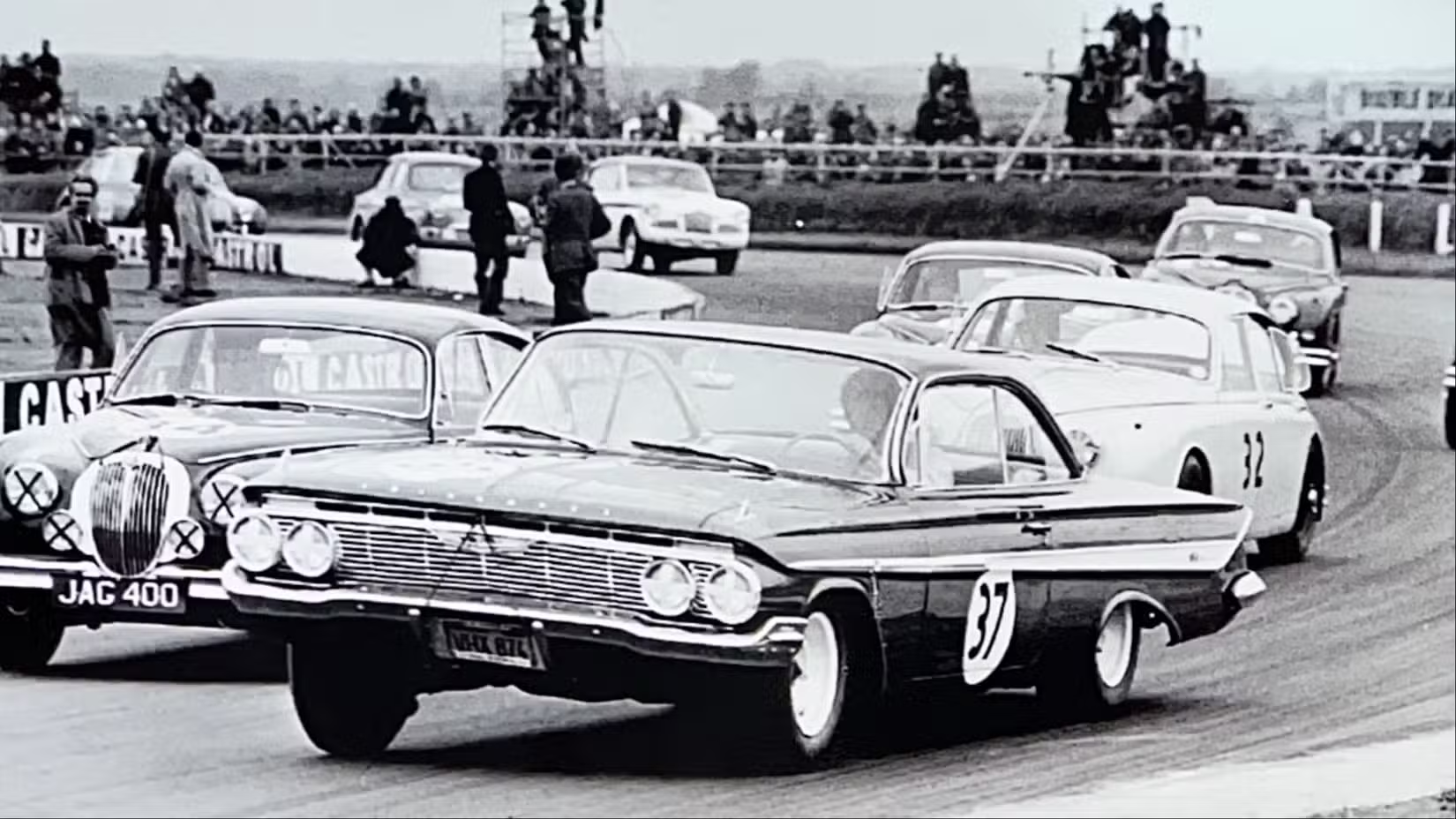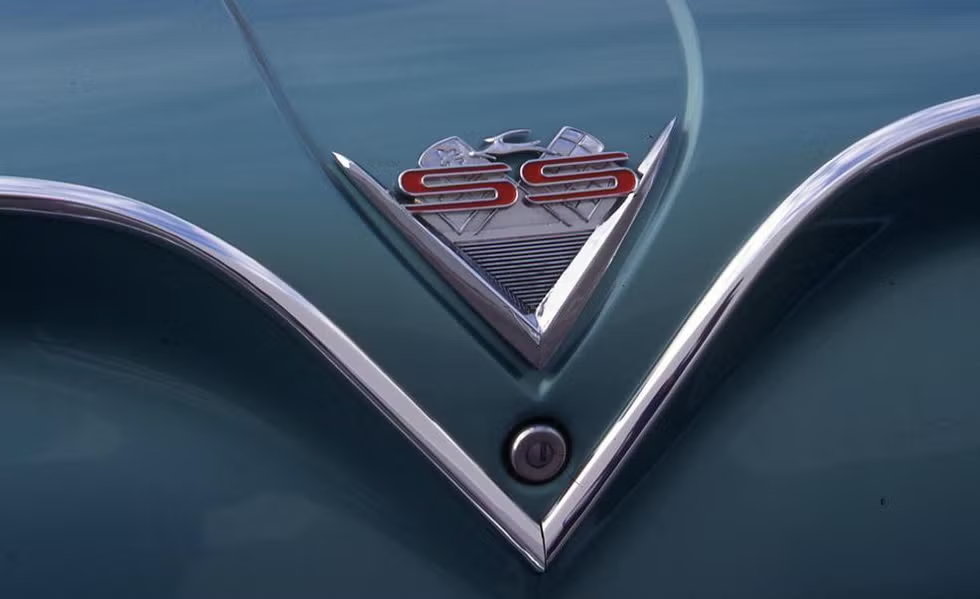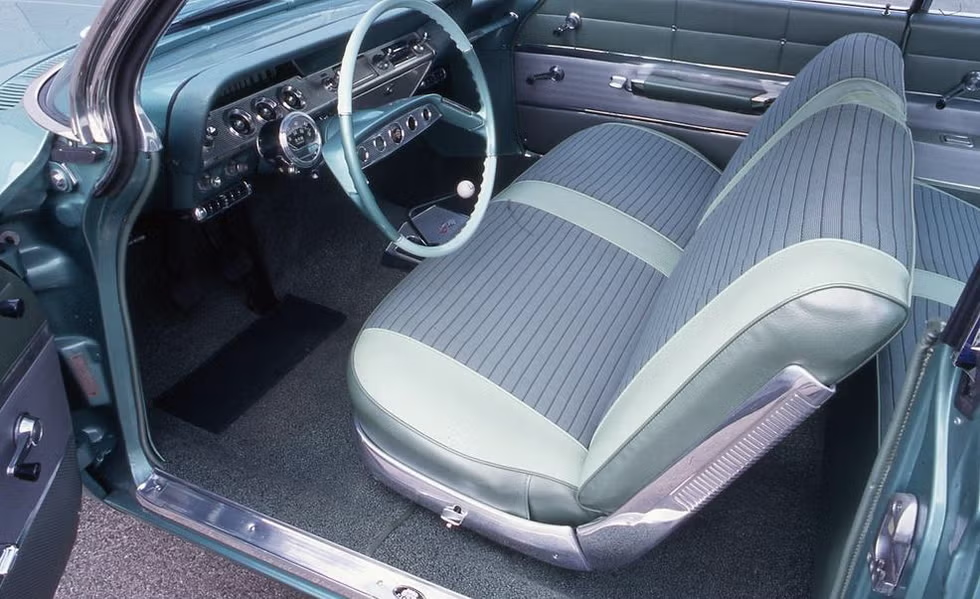This is the rarest Impala body style ever. For some inexplicable reason, in 1961 Chevrolet decided to offer its top-tier Impala in the staid 2-door body style, normally reserved for the low-trim Bel Air and Biscayne. Only 11,719 were ever built, less than 1% of all ’61 full-size Chevrolets.
In theory, one could have ordered the new Super Sport package that came out in the spring of 1961 on one of these. Unlike in later years, in 1961 it was available on any Impala except the wagon, meaning also the 4-door sedan and hardtop and the 2-door sedan. Whether any were ever actually built is a question that has not yet been answered authoritatively, although at least one has been pawned off as such, which we’ll look at in this post.
As a lover of GM’s flying roof, I had a major obsession with the 1961 Impala 2-door sedan when I was a kid because it was so rare. And I’ve always wondered if an SS version was built. Now I know.
Chevrolet made a point of noting “With A Choice of 3 new Roof Lines” that were available on the 1961 Impala.
And of course, the “bubbletop” 2-door hardtop is the one that caught by far the most attention, then and now; today it commands at least a 100% premium over the other body styles.
GM’s bubbletops dated back to 1959. Based on this concept for a rather different coupe roof for the ’61 Impala, it appears that they were considering dropping it. They did, one year later on the Impala, but went in a different direction for 1962.
The new four door hardtop was actually the most forward-looking of them, previewing where GM roofs were heading, with more traditional roofs and broader C-pillars, as would be seen on the new convertible-style coupe roof coming in 1962. The glassy and finny late fifties were on their way out.
But my love affair with the flying wing style roof that first appeared in 1959 just wasn’t quite yet ready to be over yet.
My love affair was finally requited when my brother gifted me my first car, a ’63 Corvair Monza 4-door sedan, flying wing and all. The Corvair kept that roof style going through 1964; it still looked good at the time and it still does now.
The big Chevy 4-doors were a bit too dull for my taste; the 2-door had a unique flair, especially on the Impala with its additional fake exhaust outlets and all the usual Impala accoutrements.
Visibility was of course unparalleled. And no sunburned necks like when riding in the back seat of a bubbletop.
The 1961 Chevys were a bit trimmer in all dimensions, reflecting the reality that Detroit had gone overboard starting in 1957 just as a recession hit and big cars were suddenly not so desirable. The ’61 big GM cars were actually taller too, and had better interior space utilization. Maybe the mind-set of the lingering recession was the trigger for offering the 2-door sedan in the Impala line?
Let’s consider just how rare the ’61 Impala 2-door sedan is. Given that Chevrolet built some 1,194,000 full size cars in 1961, those 11,719 2-door Impala sedans represent just under 1% of all ’61 full size Chevys and a bit over 2% of all Impalas. And there’s a few left; this is the only unmolested one I could find on the web, someone’s pictures of their car offered at North Shore Classics a few years back.
It’s equipped with the very common 170 hp two-barrel 283 V8 and Powerglide. And it does have power steering. You might be surprised, but the one I owned in my imagination back then had the 230 hp 4-barrel 283 and the 4-speed T-10 manual. Why I didn’t reach for the big 348 in my mental masturbations is lost in the mists of time, but I did have a thing about the high-revving 283 and I knew back then it was going to handle better with less weight on the front wheels. I was never overly impressed with the 348, which never lived up to the small block’s reputation. The 409 did become available late in the year, but realistically they pretty much all went to racers, as only 142 were built.
Let’s say goodbye to this nice survivor, and appreciate the fact that it has not been resto-modded, or turned into an SS clone, like the one a bit further down. But before we do that, let’s first take a look at the actual 1961 Impala SS.
It’s important to note that the ’61 SS package was very different than what it became in 1962 and subsequent years, when it became strictly a trim package with no mechanical changes from a base Impala, available even with six cylinder engines. The ’61 was a serious attempt to build an all-round highly capable sport sedan/coupe; it has Zora Arkus Duntov’s finger prints all over it. He let some journalists drive a specially-equipped ’59 sedan a couple years earlier; it was a real stormer. Chevy even advertised a version of equipped like this.
In 1961 Dan Gurney was convinced he could beat a grid of Jaguar MkIIs and others to win the British Saloon Championship. He ordered a 409 coupe with the heavy duty police suspension and brakes, and a few other goodies. At its first race at Silverstone, Gurney put the Impala on the pole, lapping the track 1.2 seconds quicker than Graham Hill in a 3.8-liter Jag. Gurney led most of the race, setting a saloon-car lap record in the process. But two laps from the finish, Gurney’s right rear wheel came off, forcing him to retire and handing victory to Hill.
Gurney installed some heavier duty NASCAR wheels and was all set to go, again at Silverstone, but the race organizers banned him, almost certainly because of intense pressure from Jaguar. The big Chevy was making them look bad, on their home turf.
The fast Impala was stored for decades, and then a few years back it was brought back to the states, fully restored.
Rather curiously, the SS package was available on all Impala body styles except the station wagon. They even chose to feature the four door hardtop in the brochure. That tends to reinforce the image of a sports sedan rather than a drag strip special, where the lighter Bel Air and Biscayne was favored. It came standard with a choice of 305, 340 or 350 hp 348 V8s and 4-speed floor-shift manual transmission (the 305 hp version was also available with Powerglide). There were special badges and interior trim, a passenger “grab bar”, electric tachometer, full wheel covers with fake knock-off hubs, large 8.00 x 14 narrow-band whitewall tires, power steering, power brakes, sintered-metallic brake linings, heavy duty front and rear suspension “to assure true sports car handling”. Somewhat ironically, bucket seats were not included (or available), as they would became the hallmark of subsequent SS models.
This very comprehensive package turned out to be too ambitious; only 453 1961 Impalas were built with the SS package.
Of those, the overwhelming majority were the 2-door sports coupe, although there were some convertibles too. There is no truly reliable source of the breakout of these various ’61 SS body styles, but the generally accepted consensus is that no 4-doors were ever built or documented. As to the 2-door sedan, there’s no proof that any were ever built, despite some claims to the contrary.
It does seem rather unlikely that any were ordered as such, as the 2-door body style in the Biscayne series tended to be favored by those racers looking for the lightest and cheapest wrapper for the 348 or 409. All the chassis and drive train elements of the 1961 SS package were also options on all the ’61 Chevys; in fact, the SS package was really just a number of mandatory options on top of a $53 basic additional charge.
That presumably covered the different badges and such.
The tachometer was really just an aftermarket unit sold through Chevrolet, but it was vastly more readable than the many silly tachs that were soon mounted down on the front end of so many consoles. There was a bit of a “console” surrounding the floor shifter for the 4-speed. There was also exclusive silver trim on the doors and such.
As to the fake ’61 Impala SS 2-door sedan I alluded to earlier, here it is. It was sold on BAT back in 2023, for $44,409. But the rather shocking thing is that the claims for what this car supposedly was/is didn’t come out in the comments until extremely late in the bidding, some of it not until after the sale concluded.
The seller, who was selling it for a deceased friend, showed “documentation” that claimed it was ordered and raced at Pikes Peak by a mechanic at a local Chevy dealer in Colorado Springs, but there was nothing to actually verify that. And it doesn’t make sense in any case.
Here’s the numerous claims the seller made for this car. Among other falsehoods, the SS package specifically was not available on the station wagon, so it makes the claim that there were 22 2-door sedans highly suspect. And no, not “all “Supersport” Impalas had the 409cid W-block engines”. Quite the contrary; of the extremely few 142 409 ’61 Chevys built, almost all documented ones were in regular Impalas, Bel Airs or Biscaynes; the great majority of ’61 SS were built with the 348. These kind of garbage “fact sheets” are all-too common at car shows, private collections and even museums.
The build plate was mounted upside down, so it had clearly been removed, and might well not be the original. These plates did not have enough info to verify what it really was anyway. But the build date was determined to be in November of 1960; the SS package did not become available until April 1961.
He also presented this “sticker” which was proven to be bogus by one or more experts. This is not how these were written, with several key discrepancies. Someone got a hold of an empty one and filled it in with a typewriter. And the 409 was specifically not available with Powerglide; it had mechanical lifters and a “race” cam. The PG was also not available on any 1962 409s either; it wasn’t until 1963 when the 340 hp “mild” 409 came along that PG was available on any 409.
I find it rather shocking that folks spending big bucks are willing to buy cars like this without really knowing what they’re buying. I guess “1961 Impala SS 409” is all it takes to break out the checkbooks.
Based on other inconsistencies, and the fact that the rear seat with its speaker grille (not used on the sedan) was from a coupe or convertible, makes it suspect that this car was even an Impala at all, but more likely “created” from a much more common Bel Air or Biscayne 2-door sedan with parts from a junked Impala.
The front bucket seats are of course not original, but presumably from a 1966-up Chevy. The original Powerglide has been replaced by a 700R4 four-speed automatic transmission, and there have been numerous upgrades to the chassis, brakes, etc..
The likelihood of the 409 being original is essentially nil, given that only 142 were ever built and this car is so not original or authentic in any other way. My guess is that it started out as a Bel Air or Biscayne and the builder happened to share some of my passion for the ’61 Chevy 2-door sedan. The difference was is that his vision went in a rather different direction than mine would have; if I was deviating from stock.
My dream ’61 2-door I would have had the new 315 hp version of the Corvette fuel injected 283. It only gave away 35 hp to the top 348, and of course was lighter for better handling. Fuel injected 283s had been available on full size Chevys few year earlier(1957-1959), but they were expensive and thus sold in very small numbers. The 348 was a cheaper solution.
But if I was building it in my head today, I’d go for the 250 hp FI 283. Unlike the lumpy mechanical-lifter cam in the highest output versions, the 250 hp version had a hydraulic cam and made significantly more torque (305 ft.lbs) and at lower engine speed. Much better for all-round driving.
Even if I didn’t ever find a genuine ’61 SS 2-door sedan in my travels on the web, I’m happy to know there’s still one (or more) original Impala 2-doors out there, so that I can reignite my childhood fantasies one more time.
Related reading:
Bring A Trailer: 1961 Chevrolet Impala SS 409 2-Door Sedan
Curbside Classic: 1961 Chevrolet Bel Air Sport Sedan – The Last Bel Air Four Door Hardtop
Curbside Classic: 1961 Chevrolet Impala Sport Coupe – Wherein The Author Meets His Nemesis And Finds Love by JPCavanaugh
Curbside Classic: 1961 Chevrolet Impala 4-Door Hardtop–Staying Close to Home by S. Pellegrino
Vintage Ad: I ‘Built’ My Chevy To Handle Like A Sports Car…For Five! Another Not-Niedermeyer-Mobile



















































this black ’61 Impala 2 dr sedan is seen around Connecticut at car events
Wow, an original window sticker from 1961! Love it!
It’s a fraud. Read the article.
Provenance can be, a real minefield, create a convincing looking document, have it ‘apraised’ and bingo. If the buyer wants it to be genuine it’ll be a done deal. Back to the car, I really like the 1961 Chevrolet full size. I too think the two door sedan is the pick of the bunch. For me a Belair with a mild 283, powerglide, power steering & power brakes in light metallic blue please
Great sleuthing there, Paul. Sad and fascinating at the same time.
Could the subject car have been originally ordered with no heater or does he just have a leaky core at the moment?
The latter. It was pointed out in the ad.
I read that whole BAT sale. Only a hand full questioning the background on that car. I am not a fan of BAT. Seems to be populated by a lot of back slappers when reading the comments. They tend not to like people who are contrary such as me when I once made critical comments about a Cougar. It amazes me how easy it is to separate money from a buyer when one is talking cars.
That’s why I’m here not there. On a different note I’m preparing to scratch build 1:144 Casablancaclass CVE, one of the Taffy 3 ships, do you know of any good sources of photos/drawings excluding Navsource which I’ve found?
Thanks, Ed
It’s a cool idea as a clone or phantom. Whoever created it should have left it at that. However why the hell did he use a powerglide instead of the available four speed stick?
My dad bought a ’61 4-dr Biscayne with the small V-8, 3 on-the-tree w/overdrive. As I recall, one pulled a little lever under the dash to actuate the overdrive. Of course, it was ugly, but serviceable. And would sail along the highways for hours at triple digits.